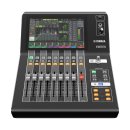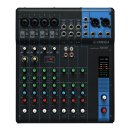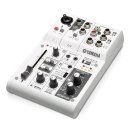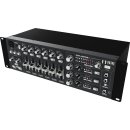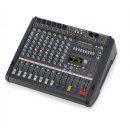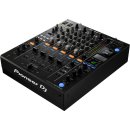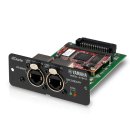Mixers
Buy your new audio mixer here. We have all the good brands, and always at the right price
When creating a mixer guide, the big question is where to start - here we will provide a basic overview so that even those who are completely new to a mixer can follow along. If you already have some understanding of the knobs, you have the opportunity here to refresh the basic principles. In this guide, we focus on small analog mixers, as this is often the type you will encounter if you haven't used a mixer before.
What does a mixer do?
Simply put, a mixer takes all your audio sources (microphones, keyboards, players, etc.) and sends them out in a stereo signal to your speakers. Additionally, you can control levels and shape the sound with effects and EQ - more on that later!
Channel Tour
An analog mixer is composed of a number of channels, each of which has several stages. Not all mixers have all stages, but the most common ones are: Gain, EQ, AUX-send, panning, and finally a fader.
Gain: When you plug a microphone into the microphone input on the mixer, you're actually plugging it into a microphone preamp, which amplifies the microphone's signal to a level the mixer can work with. You control the preamp with the gain knob.
Hipass/Lowcut: As the next step on the channel, many mixers have a hipass/lowcut button, which removes the lowest part of the signal. It's a good idea to engage it on most signals, especially on bass-heavy instruments like bass guitar, kick drum, and audio playback.
EQ: The next step is an equalizer or EQ, which helps you shape the signal. It can be structured differently, but fundamentally, there will be two, three, or four bands, each controlling bass, midrange, and treble. For example, it often sounds good to cut some low-end and boost a bit of top on a vocal microphone. Some EQs have a parametric midrange. There will be one knob controlling the frequency and another controlling whether the frequency is boosted or cut.
AUX Send: Many mixers have one or more AUX sends. If the mixer has built-in effects, there will be an AUX send that sends signal from individual channels to the effects unit. AUX sends are also used to send signal to external effects units and to stage monitors.
Panning: The last step on the channel before the fader is the panning knob. If it's centered (at 12 o'clock), there will be an equal amount of signal in the left and right channels. Use panning, for example, to separate two vocals in the mix by placing them slightly to the left and right, respectively.
Mute: Each channel has a mute button, which "mutes" the respective channel. On Yamaha mixers, there is instead an ON button that needs to be engaged for the channel to be active.
Fader: Each channel has a fader that determines how much of the signal from the channel is sent to the stereo mix. Next to the fader, on some mixers, there are toggle switches where you can choose whether the channel should be sent to the stereo mix, to a group, or both. This might be where the issue is if you're not getting any sound from the channel.
Glossary
There are already many terms in play, and it doesn't get any easier when some things have multiple names. Therefore, here's a quick little dictionary:
LR, left-right, stereo out, stereomix, stereo: all words for the same thing, namely the stereo signal you send out of the mixer to your speakers.
AUX, mon, monitor, send: an extra send besides the stereo mix, used to send a signal to effects processors or monitors. An AUX send can be post-fader or pre-fader, which means the signal is sent either before or after the channel's fader. If it's sent pre-fader, the same amount of signal will always be sent, regardless of how high or low the channel's fader is. This is useful, for example, if you're using the send for a stage monitor. Here, you won't change the sound on stage even if you adjust the sound for the audience. If it's sent post-fader, however, the amount of signal will vary depending on how much you've turned up the fader. This is useful if you're using the send for an effects processor. For example, if you've turned down the vocals a lot, it's not ideal if there's still a lot of reverb coming through the speakers - they should ideally match.
XLR, microphone connector: XLR connectors are the three-pronged connectors you're familiar with from microphone cables. They're usually found on signal cables, which are also used to send signals from the mixer to the amplifier.
EQ (equalizer): Shapes a sound signal. On each channel, there's often a parametric EQ where you control bass, midrange, and treble. Some mixers also have a graphic EQ on the stereo mix, where you can shape the final sound. On a graphic EQ, there are a number of sliders, each adjusting a specific frequency range.
Group, subgroup, sub group, group: Many mixers have one or more groups. A group can be used for various purposes, for example, you can have an external compressor connected to a group, where you send all your drum tracks or vocal tracks to. You send to a group using a button next to the fader on each channel.
Tape, tape in, phono: Usually a set of stereo phono jacks that can be used to connect, for example, a mini-jack to phono cable, so you can play music from a phone or computer.
PFL: Many mixers have a PFL button on each channel. PFL stands for Pre Fader Listen, and when you turn it on, the VU meter will only show input for the channel or channels that PFL is enabled for. It's quite useful when setting gain on a microphone to see how much signal is coming into the channel.
Return, stereo return: A simple stereo input with only a volume control. It is used to send a signal back into the mixer that has been processed in an effects unit, EQ, or compressor. You could say that the signal is "returned" to the mixer.
Analog or digital?
This guide is based on an analog mixer, but the principles are the same in a digital mixer - there are just a few more options and features. Starting with an analog mixer can be a good idea as it provides a good overview of what's happening with the signals.
Get Through
Troubleshooting is an important skill to have when you're dealing with a mixer and there's no sound coming through. A good approach is to start at the beginning of the signal chain - for example, with a microphone. Where does the signal enter the mixer, is the gain turned up, is the channel unmuted, is the fader turned up, is the channel sent to the stereo mix, is there signal coming in (here, PFL is handy again), etc. You might also encounter a faulty cable - in that case, you'll need to test it out. Generally, it's about keeping a clear head and taking one step at a time - otherwise, you might end up confusing yourself.
A good tip is always to turn on the mixer before you turn on your amplifier or active speakers. That way, you avoid the "pop" that would otherwise occur in the speakers when the mixer is turned on.
Dive In!
There are many names and terms, but in reality, it's not rocket science. Give it a shot and think logically - it will surely work out :). And if you've bought your mixer from us, we'll guide you through so you can get the sound flowing!
Mixers
On this page you will find our wide range of mixers. We have many types of mixers and mixing desks for bands and all types of events, such as live mixers, power mixers, rack mixers and small mixers.
So if you're looking for a new audio mixer for your band, home studio or a larger event, you've come to the right place.
Questions and answers about mixers and mixing desks
What is a mixer?
A PA mixer, audio mixer or a mixing desk is the device you use to "mix" the sound from several different audio sources. There are many types of mixers and mixing desks for all types of events.
There are live mixers, studio mixers and mixing desks for discos. A studio mixer is used in smaller studios as well as more advanced recording studios. The live mixer is mainly used for live concerts and other events that require live PA. It is the mixer that electronically mixes the many sound sources and sends them to an amplifier or other destination. The studio mixer is the heart of the process that makes it possible to connect different audio sources to a recording and balance, position and equalize the different audio channels. It is through the audio mixer that the producer in the studio or the sound engineer at concerts ensures that the many sonic compositions become an overall well-sounding product. Live and studio mixers have the same basic functions, but use them differently. The live mixer often has more inputs than the studio mixer, as there is a need to connect more sound sources to the system. The studio mixer has a greater need to get a good signal in and out of a multitrack recorder. The studio mixer must therefore be able to route individual tracks or channel groups to individual recording tracks. The live mixer, on the other hand, needs to be able to handle inputs from many different sound sources at once and therefore has multiple inputs.
In general, there are three types of mixers:
- Analog mixer
Analog signal paths that do not convert to digital data. Preferred by many for its ease of use. - Digital mixers
Analog and digital signal paths that convert both ways. Good for touring productions as it has the ability to save settings, making setup from time to time easier. - The new generation of analog mixers
They have USB and FireWire and are a kind of all-in-one solution.
How do I choose the right mixer?
Knowing which mixer to choose is difficult and depends on a number of different factors. Before you buy a mixer, it is therefore important to be clear about what the mixer will be used for, how many sound sources you need, etc. There are so many different brands, types and price ranges, so it is important to be clear about what you need and prioritize before making a decision.
I have a small home studio, do I need a mixer?
It all depends on what kind of home studio you have. For example, if you have limited hardware, want a completely digital signal or have a very fast computer and want to use a lot of virtual instruments, you don't necessarily need an audio mixer. Check out our studio equipment section so you can produce your own electronic music instead.
How many channels do I need?
More than you might think. In a nutshell. It's always a good idea to go for a mixer with more channels than you need, as it helps to future-proof your mixer and it's generally better to have a few too many than too few.
How much does a good mixer cost?
We have mixers in all price ranges, but it's important to understand that you get what you pay for. A quality mixer is expensive, but if you don't have the budget, we'll find a reasonable alternative.
Buying guide for audio mixers and mixing consoles
As mentioned, it can be difficult to know which mixer to choose. That's why we've put together a checklist that might be useful for you to go through before you decide:
- What do I need the mixer for? Multitrack recordings, live PA or both?
- What is my budget? Remember that price and quality are inextricably linked
- How many channels do I need? Remember to think about future-proofing!
- Do I need my mixer to be highly mobile or not move around a lot?
If you are unsure about which mixer to choose, feel free to contact our customer service team, who are ready to help you.
Large selection of audio equipment - also for professionals
We also have a wide selection of other audio equipment, such as amplifiers, speakers, microphones and recorders.
If you are a professional DJ, we recommend you take a look at our DJ equipment, where you will find DJ mixers, DJ players and DJ controllers.
Buy your new mixer at SoundStoreXL and get a great deal!



